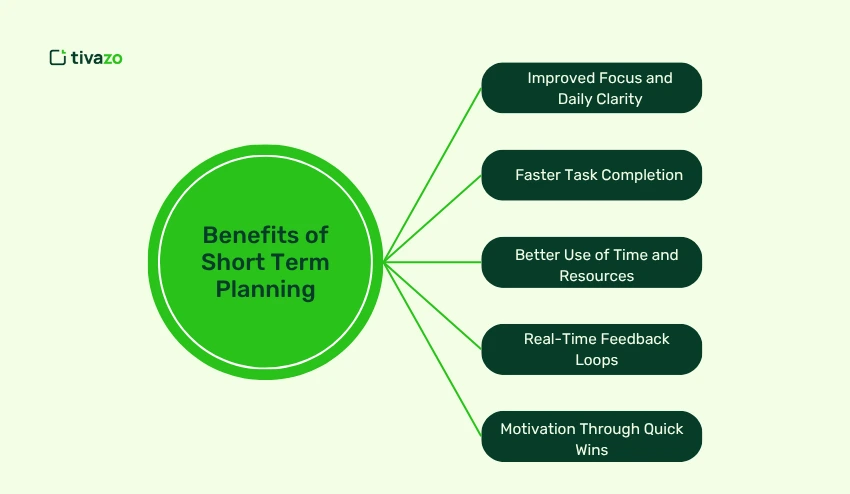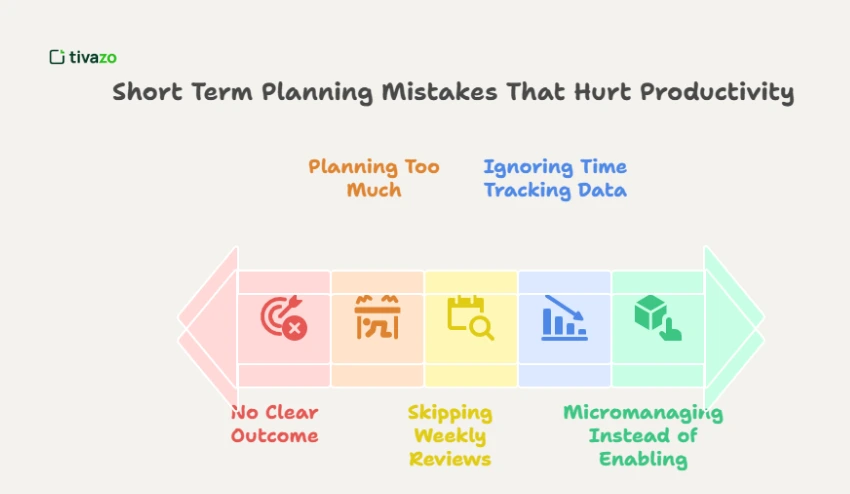In a world of extreme distraction, agility is more than a concept—it is essential for survival. The best teams of 2025 are not simply setting an annual goal and hoping their team makes some progress. They behave with clarity and intention in the short term, creating and executing on weekly plans that move the organization along in support of their long-term vision. Working in the short term doesn’t mean abandoning your big picture goals.
It means making progress visible, momentum measurable, and success repeatable, week after week. This ultimate guide will help you understand what short term planning means, why it is important for team productivity, and how to leverage planning to deliver consistent results. You will learn proven strategies, avoid common mistakes, and also recall and deploy the tools and workflows used by high-performing teams to stay focused and on track. Let’s go.
Key Highlights:
- What Is Short Term Planning
- Short Term Planning Strategies
- Planning for Different Team Types
- Short Term Planning Mistakes That Hurt
What Is Short Term Planning?
Short term planning is the act of laying out a specific, actionable task or goal — usually a 4-week plan — to keep your team focused, flexible, and more productive. Short term plans are tactical, time-bound, and output-focused; in contrast, long-term planning (months or years) is not. For example, “Launch new website this quarter” is not a short term plan; rather, a short term plan would be “design homepage wireframe and content by Friday”.
Short term plans allow your team the capability to pivot quickly, think ahead, and measure results since you are looking are plans that are the right time bounds, and because each week is a bit of a new date, to create a more consistent quality work process.
Short term planning = clarity + accountability + agility.
The Benefits of Short Term Planning for Team Productivity
Benefits of Short Term Planning are:

- Improved Focus and Daily Clarity
- Once everyone on your team knows and articulates what needs to be done this week, distractions disappear. To lessen the burden on the brain and decision fatigue, use planning blocks each week.
- Faster Task Completion
- The deadline sets a level of urgency. You will be working on a smaller scope, which means fewer potential blockers. Teams can ship more rapidly, iterate more frequently, and celebrate their progress more often.
- Better Use of Time and Resources
- Short term planning shines a light on time sink holes and bottlenecks. When you keep track of how the actual time of resources is spent, a manager can hone in on time allocation and eliminate physical and mental waste.
- Real-Time Feedback Loops
- Utilizing weekly check-ins and performance reviews allows teams to change course if need be. Mistakes are caught. Wins are repeated. Creates a culture of momentum.
- Motivation Through Quick Wins
- Disciplining ourselves towards long-term goals can feel far away. But hit a Friday deadline? That’s tangible. Short-term planning provides your team with a means of measuring progress quickly.
“Short-term planning isn’t about thinking small. It’s about making sure you win small every week so you can win big over time.”
5 Short-Term Planning Strategies That Work
5 Short-Term Planning Strategies are:

Start with Weekly SMART Goals
Instead of fuzzy commitments like “work on marketing,” use SMART goals – Specific, Measurable, Achievable, Relevant, and Time-bound. For example, “Publish 3 blog posts by Thursday,” or “Onboard 5 new users this week”. Weekly SMART goals provide clarity, urgency, and focus for your team. It’s easier to execute when everyone knows what success looks like and is measurable.
Break Tasks into Daily Action Blocks
Once your SMART goals are set for the week, break them down into daily action items. Think of them as “micro commitments” that continue to fit into each day’s flow. You might choose to task batched work, time block work for focus protection, or the Pomodoro Technique – steady focus in 25-minute work sprints to reduce fatigue overall. These approaches keep your team focused on completed tasks in micro blocks of time, rather than overwhelming larger blocks of time.
Use Tools to Stay Accountable
Plans fail without execution. That’s where tools become effective. Use productivity solutions to track time by project, task, and team member. See what time is spent being productive versus being distracted, which will help create better habits based on data. When your team can engage in real-time accountability, goals grow to action – especially when they demonstrate real work (or not).
Review Progress Every Friday
Every Friday, devote 10 to 15 minutes to a check-in on the team’s progress and hang out together. Ask: What did we get done? What slipped, and why? What will we do differently next week? A weekly ritual allows for review of failures and accomplishments to avoid repeating mistakes as well as celebrating successes. Review functions to facilitate reflection and learning. A weekly review of work signals that the work is valued. Teams that review weekly always outperform teams that “set and forget.”
Celebrate Mini Milestones
Execution-oriented cultures are rooted in appreciation for accomplishments large and small. When someone reaches a mini-milestone—finishes a sprint, brings in a new client, finishes a milestone for the week, or publishes a key asset—pause the team or at least make a note and celebrate it. Use Slack shout-out, emojis, or a virtual high-five. These triumphs fuel morale, strengthen team alignment, and provide motivation to build momentum around weekly execution.
Remember: Planning is only powerful when it is continuous. Weekly execution, review, and recognition convert short-term planning into long-term execution and results.
Short Term Planning vs. Long Term Planning: What’s the Difference?
| Criteria | Short Term Planning | Long Term Planning |
| Timeframe | 1–4 weeks | 6 months–5 years |
| Goal Type | Tactical, iterative | Strategic, visionary |
| Flexibility | High | Lower |
| Review Cycle | Weekly | Quarterly/Yearly |
Use short term plans to execute the long-term vision in manageable sprints.
How Managers Can Lead Effective Short Term Plans
Effective short term planning doesn’t happen in a vacuum. It begins at the top. Managers are essentially a conduit for cascading company-wide objectives into focused action plans every week. The first step is to align team objectives to the broader OKRs. Make sure the team understands how the weekly priorities contribute to the long-term strategy for success. Next, managers should model the behavior they want from their team. Plan your coming week publicly and share that plan.
When a leader is transparent with their priorities, there is no question about ownership. If the team is clear on their priorities, there is no need for micromanagement, and you can use a time tracking tool like Tivazo to see what progress has been made, as well as help remove barriers periodically in real time.
Weekly stand-ups deliver on accountability and allow the team to acknowledge wins, challenges, and shift priorities regularly. Successful leadership and ideal tools allow for a culture of short term planning to become habitual for everyone in the team, not just a memo from the manager.
Planning for Different Team Types: Remote, In-Office & Hybrid
There is no universal short term planning method. A remote, in-office, or hybrid team plan is contingent upon how your team chooses to work together. Below are suggested approaches for how you can best demonstrate and/or facilitate weekly execution for each one of these environments:
Remote Teams
While remote teams value autonomy, the lack of visibility into both accountability and structure can lead to the potential for work to fall off the rails. This means that async check-ins – Slack, Loom, or your company’s dashboard (Tivazo) – are critical; rather than being done via a meeting, every member of the team describes their daily work goals and obstacles in writing or video; and hour tracking becomes critical, too; it is well-established that by simply tracking time and outcomes, remote teams experience higher levels of accountability without requiring micromanagement. Additionally, maintaining team morale and sense of togetherness over multiple time zones can be accomplished by celebrating wins in team channels (by way of reactions, GIFs, or direct shout-outs).
In-Office Teams
In-office teams enjoy the advantages of co-located, real-time collaboration and ambient awareness, but they also run the risk of spontaneous interruptions and distractions. To counter the potential for havoc, daily huddles (5–10 min. stand-ups) can help everyone align on their priorities quickly. With everyone in the same room together, it won’t be difficult to get everyone to see roadblocks and adjust tasks in real-time. Tivazo screens can be displayed on the office monitors to visualize a live time tracking, which keeps the room fully focused and accountable. This transforms into visible, tangible progress and incorporates planning into everyone’s daily rhythm.
Hybrid Teams
Hybrid teams straddle the line between freedom and coordination. With this level of freedom, they can be forgetful on how to coordinate weekly planning across both physical and digital spaces. Often our first step is to share weekly goals as a team via shared dashboards, which everyone can access—it is amazing to see that everyone can be working together even if they are not in the same room! Asynchronous updates can be used with a fixed “sync” day.
Many companies use Fridays for sync day to create a weekly review. This mix provides everyone an opportunity to have their voices heard and brings the vibrancy of in-office energy without being left out. Short term planning will keep hybrid teams aligned, synchronized, and focused, no matter where they are signing in from.
Why Most Teams Fail at Short Term Planning (And How to Fix It)
There is a discipline and intention behind effective short term planning—one that is forged by solid leadership and intentional habits. Leaders are responsible for establishing the atmosphere, often aligned with some weekly team goals. Then, the team can establish a connection between their daily task and the larger funnel of objectives, e.g., the company’s OKR for the quarter. This requires leadership to establish their expectations of planning/writing including modeling their weekly agenda, sharing their weekly plans, and providing team members with an autonomous environment, establishing accountability.
Most teams fail due to a habitual proclivity to equate activity as the outcome, coupled with not tracking where time is actually spent or not conducting reviews frequently enough to correct course. The answer is to set expectations that have unambiguous goals, measure the progress by tracking time spent, and that reflection is an intentional weekly habit that should not be negotiable.
By leading consistently and using the right tools, teams will be more thoughtful about planning/time management, and will be able to work more effectively and efficiently while having the ability to swiftly react to changing circumstances—this will put your organization at an enormous advantage as you hone in on short-term planning.
Short Term Planning Mistakes That Hurt Productivity
Even the best-laid plans can go awry if the short-term planning process is not completed carefully. Mindfully avoiding these 3 common traps can be the difference between a productive week and wasted time.

1. No Clear Outcome or Deadline
“Work on the project” is just too vague. What does working on the project entail? Elements of the project? What does success look like? And when is it due? Without a specific item to deliver and a time frame to limit it, tasks will linger, and motivation will wane. Replace vague goals with focused sentences like – “Submit final slide deck by Thursday, 4 pm”.
Fix: Use SMART goals with precise deadlines management techniques.
2. Planning Too Much at Once
When everything is everything or declining to set priorities of tasks, you become fatigued or exhausted and wonder why nothing is getting done. You difficult to prioritize tasks, and none of them are being done well. Always quality overall number of tasks in short term planning.
Fix: Limit your weekly focus to 2–3 meaningful goals.
3. Skipping Weekly Reviews
Without emphasizing a brief weekly review, teams fail to establish a regular feedback loop. In failing to get together, even for a few minutes, they fail to notice patterns within their work, fail to notice mistakes when they occur, and fail to build upon small wins. Keeps reviews simple; they do not need to be particularly long.
Fix: Block 10 minutes every Friday to review wins, misses, and lessons learned.
4. Ignoring Time Tracking Data
When you’re uncertain about various time uses, you’re set to making mistakes, which is not the best way to enhance efficiency. Time tracking shows a real look at aspects of team energy, what works, what doesn’t, and how to spend time more effectively next week.
Fix: Use time tracking tools to inform and refine plans.
5. Micromanaging Instead of Enabling
Micromanaging does not improve productivity; it strangles it. Short term planning works well when teams are permitted to use their resources (autonomy) and be responsible for their actions (accountability).
Fix: Set clear expectations, then step back and let your team deliver. Check in, not check on
Examples of Effective Short Term Planning at Work
Remote Marketing Team (Content Sprint)
The remote marketing team organized to post 4 blog posts in 5 days. They assigned blog posts to multiple writers and established deadlines for drafts to be done. They used Tivazo to track the time spent on various tasks, which assisted in getting writers balanced, as well as identifying early on if they had any blockers, keeping the team focused on the sprint and schedule.
Client Onboarding Team (3-Day Workflow)
In the case of onboarding 2 clients by Wednesday, the client onboarding breakdown consisted of Calls, Setup, and Training. By tracking the hours spent in Tivazo, the team was able to identify delays, as well as how to ultimately make optimal use of their time, and provide a very seamless experience for the clients, hence delivering in a timely manner as expected.
SaaS Product Team (Bug Fix Sprint)
In the case of fixing bugs, the SaaS products team had a target of identifying and fixing 10 high-priority bugs. They assigned tasks by severity, tracked developer hours with Tivazo, and each day identified any potential blockers. A daily check-in was used to easily solve problems, which helped move on from bug identification and resolution of bugs quickly while improving the overall quality of their product.
Final Thoughts: Start Planning Smarter, Not Harder
Short-term planning is not only a nice-to-have– it is the starting point for achieving genuine focus, ongoing momentum, and tangible results. Whether your team is remote at the start-up stage or you are a large enterprise company with an established strategy, the weekly or 3-4 week plan is where your high-level plans become relevant, and where there is evidence of action.
By having your SMART goals identified, measuring and tracking your time continuously, regularly reviewing the past week, reflecting on your direction, and making any necessary course corrections on the fly, your team is learning to be productive faster and smarter rather than longer and harder.
With tools like Tivazo, you get the visibility and clarity that removes the guesswork, reduces uncertainty, and minimizes wasted time, plus creates accountability and supports continuous improvement. Don’t allow a fragmented priority list or distractions to derail your team’s productivity; begin the process of becoming a short-term planning master today, and measure your results increase.
FAQs
Why is short term planning important?
It boosts team agility, sharpens priorities, and drives faster execution.
What’s a good example of a short term plan?
“Design homepage wireframe by Friday” is a clear, actionable short term goal.
Can short term planning work for remote teams?
Yes. Weekly check-ins, clear goals, and time tracking keep remote teams aligned.
How often should you review short term plans?
Weekly reviews are ideal to adjust priorities, track wins, and stay on course




